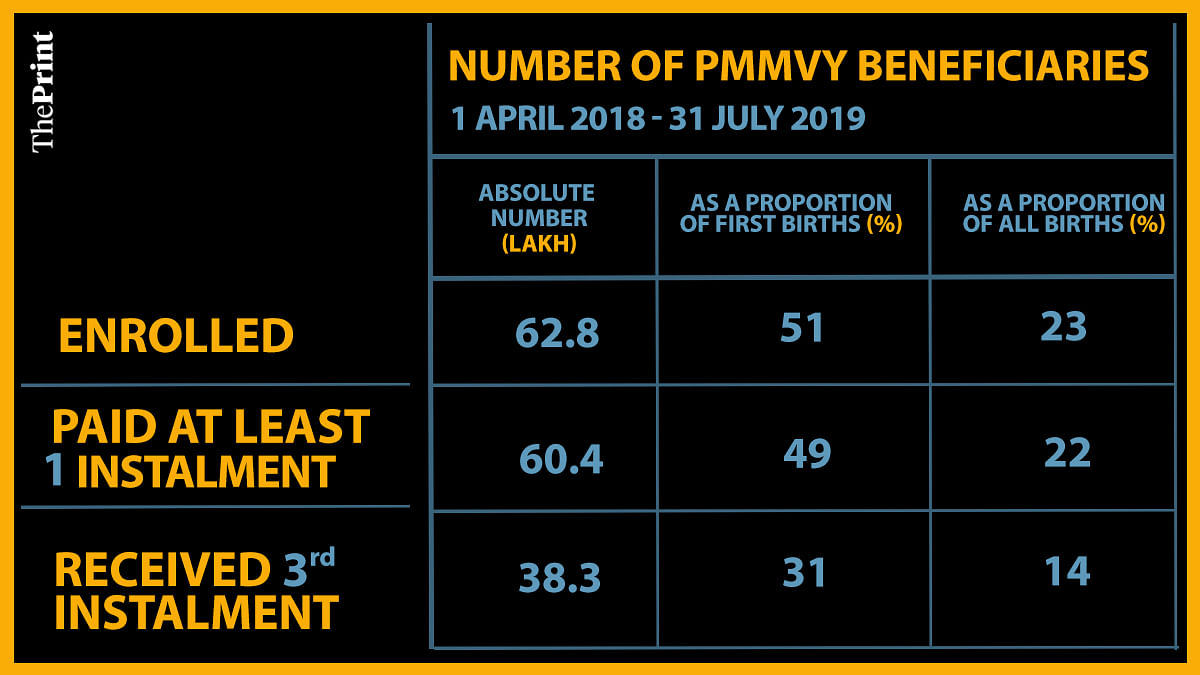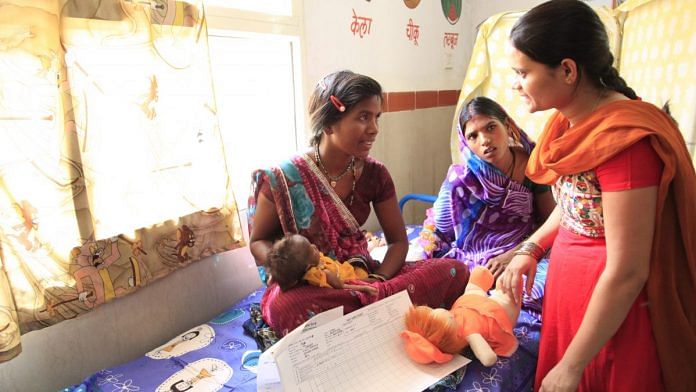New Delhi: A flagship Modi government scheme for financial assistance to first-time mothers has reached 10 million or 1 crore women since its launch in 2017, the Ministry of Women and Child (WCD) Development has said.
The ministry, led by BJP MP Smriti Irani, was replying to a query from ThePrint about a survey that claims the Pradhan Mantri Matru Vandana Yojana (PMMVY) only reached 49 per cent of its targeted beneficiaries between 1 April 2018 and 31 July 2019.
The survey, conducted by economists Reetika Khera and Jean Drèze, was released Monday and is based on an RTI reply from the ministry. According to the RTI reply, the government scheme had 60.4 lakh beneficiaries between 1 April 2018 and 31 July 2019.
The ministry cited a speech made by Irani Sunday, where she said “the PMMVY today has 10 million or 1 crore beneficiaries”.
“The WCD minister is on record regarding the number of beneficiaries,” Press Information Bureau (PIB) additional director general and WCD spokesperson Monideepa Mukherjee said. “The speech includes the official figures.”
The ministry denied that a huge number of pregnant women were left out of the scheme, as claimed by the Khera-Drèze survey.
To prevent undernutrition
Under the PMMVY, the government transfers Rs 5,000 in cash to women of 19 years or above for their first live birth. The money is transferred in three instalments — Rs 1,000 on the registration of the pregnancy, Rs 2,000 after the second trimester is completed and Rs 2,000 after childbirth.
The idea is to ensure the mother and infant don’t suffer on account of undernutrition, which can have a severe impact on the health of a newborn.
Khera and Drèze’s Jaccha-Baccha Survey (JABS) analyses the implementation of the scheme across the country, but particularly in six states — Chhattisgarh, Himachal Pradesh, Jharkhand, Odisha, Madhya Pradesh and Uttar Pradesh.
Based on the figures provided in the RTI reply, Khera and Drèze employed population figures, birth rate and the average fertility rate to calculate that just about 22 per cent of all women across the country believed to have given birth during the period benefited under the scheme. The figure was 49 per cent for eligible women, that is, first-time mothers aged 19 and above, the survey says.

“The number of births is estimated at 270.5 lakh, based on 2017 data for India’s population (133.9 crore) and birth rate (20.2 per 1,000). Of these, 123 lakh are counted as first births, based on a total fertility rate of 2.2 children per woman (implying that 45.5 per cent of all births are first births),” the survey states.
Also Read: Smriti Irani – controversial in Modi’s first term, ‘disinterested & aloof’ in second
‘Ignorance about the scheme’
Jaccha-Baccha Survey (JABS) analyses the implementation of the scheme across the country, but particularly in six states — Chhattisgarh, Himachal Pradesh, Jharkhand, Odisha, Madhya Pradesh and Uttar Pradesh.
The economists surveyed 706 women in the 6 states, 342 of whom were pregnant and 364 nursing.
In the six states, the economists reportedly found that many pregnant women get excluded from the benefits of the scheme because of various factors.
First, only first-time mothers are eligible under the scheme, which the economists argue defeats the promise of the 2013 National Food Security Act (NFSA).
“All pregnant women are entitled to maternity benefits under the National Food Security Act, but if the actual coverage is just 22 per cent, that’s worrisome,” Khera told ThePrint.
According to the NFSA, pregnant women and lactating mothers are entitled to receive maternity benefits of not less than Rs 6,000.
“The PMMVY, for some reason, also reduces this sum from Rs 6,000 to Rs 5,000,” Khera said.
Secondly, the economists point out in the survey that Aadhaar card is the only acceptable identity document to apply for the scheme — not just the mother’s, but also that of her husband.
Thirdly, they say, the application procedure becomes extremely cumbersome and complicated, often leading to rejections. One-fifth of the respondents who applied for PMMVY reported experiencing Aadhaar-related problems, the survey claims.
“Demographic data glitches (e.g. typos in Aadhaar number, misspelling of names, wrong date of birth on Aadhaar, mismatch between Aadhaar card and other records, etc) can all lead to the PMMVY application getting rejected or delayed,” the survey notes.
The survey also claims to have found widespread ignorance about the scheme — only 66 per cent of the eligible beneficiaries interviewed said they were aware of the scheme, while only 60 per cent applied.
Also Read: How Kerala beat UP and all others on Niti Aayog Health Index



